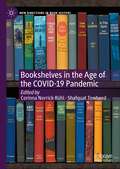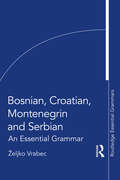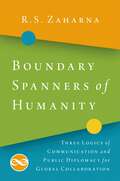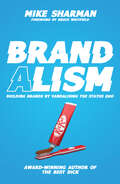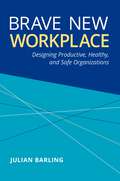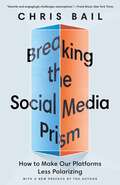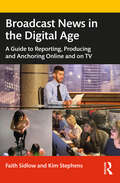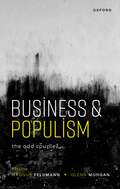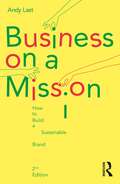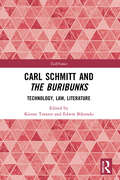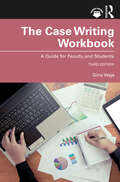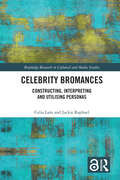- Table View
- List View
Bookshelves in the Age of the COVID-19 Pandemic (New Directions in Book History)
by Corinna Norrick-Rühl Shafquat TowheedBookshelves in the Age of the COVID-19 Pandemic provides the first detailed scholarly investigation of the cultural phenomenon of bookshelves (and the social practices around them) since the start of the pandemic in March 2020. With a foreword by Lydia Pyne, author of Bookshelf (2016), the volume brings together 17 scholars from 6 countries (Australia, Canada, Germany, the Netherlands, the UK, and the USA) with expertise in literary studies, book history, publishing, visual arts, and pedagogy to critically examine the role of bookshelves during the current pandemic. This volume interrogates the complex relationship between the physical book and its digital manifestation via online platforms, a relationship brought to widespread public and scholarly attention by the global shift to working from home and the rise of online pedagogy. It also goes beyond the (digital) bookshelf to consider bookselling, book accessibility, and pandemic reading habits.
Bosnian, Croatian, Montenegrin and Serbian: An Essential Grammar (Routledge Essential Grammars)
by Željko VrabecBosnian, Croatian, Montenegrin and Serbian: An Essential Grammar is intended for beginners and intermediate students who need a reference that explains grammar in straightforward terms. It covers all the main areas of the modern single BCMS grammatical system in an accessible way, and free from jargon. When linguistic terminology is used, it is explained in layman’s terms, the logic of a rule is presented simply and near parallels are drawn with English. This book covers all the grammar necessary for everyday communication (reaching B1 and B2 of the CEFR, ACTFL Intermediate-Intermediate- Mid). The book comprises of extensive chapters on all parts of speech, the creation of different word forms (endings for cases in nouns and adjectives, case forms for pronouns, tenses, verbal modes, verbal aspect etc.) and their uses in sentences. Each rule is illustrated with numerous examples from everyday living language used in Bosnia-Herzegovina, Croatia, Montenegro and Serbia. It is a unique reference book in English aimed at this level of language study that treats BCMS as a single grammar system, explaining and highlighting all the small differences between the four variants of this polycentric language.
Bosnian, Croatian, Montenegrin and Serbian: An Essential Grammar (Routledge Essential Grammars)
by Željko VrabecBosnian, Croatian, Montenegrin and Serbian: An Essential Grammar is intended for beginners and intermediate students who need a reference that explains grammar in straightforward terms. It covers all the main areas of the modern single BCMS grammatical system in an accessible way, and free from jargon. When linguistic terminology is used, it is explained in layman’s terms, the logic of a rule is presented simply and near parallels are drawn with English. This book covers all the grammar necessary for everyday communication (reaching B1 and B2 of the CEFR, ACTFL Intermediate-Intermediate- Mid). The book comprises of extensive chapters on all parts of speech, the creation of different word forms (endings for cases in nouns and adjectives, case forms for pronouns, tenses, verbal modes, verbal aspect etc.) and their uses in sentences. Each rule is illustrated with numerous examples from everyday living language used in Bosnia-Herzegovina, Croatia, Montenegro and Serbia. It is a unique reference book in English aimed at this level of language study that treats BCMS as a single grammar system, explaining and highlighting all the small differences between the four variants of this polycentric language.
Boundary Spanners of Humanity: Three Logics of Communications and Public Diplomacy for Global Collaboration
by R.S. ZaharnaWritten by a leading scholar of public diplomacy, Boundary Spanners of Humanity introduces a pan-human vision of communication that can revolutionize how we collaborate to solve global problems. Never before has humanity enjoyed better technological capabilities for interconnection than today. Ironically, rather than benefiting from the global pool of human resources and intellectual wealth to solve shared problems, nations are experiencing public discord and global divisions. Boundary Spanners of Humanity tackles the challenge of how to enhance global collaboration by introducing three pan-human logics of human communication and public diplomacy that can transform how we view diversity in an interconnected world. R.S. Zaharna begins by asking why the very tools needed for global collaboration-communication and public diplomacy-are undermining our efforts to work together. Her research reveals how contemporary communication is based on a nineteenth-century mindset of separateness that divided people into mutually exclusive cultural and national categories. That mindset reinforces human divisions and erodes global collaboration. In a radical break from conventional models, Zaharna introduces a vision of humanity-centered public diplomacy featuring three complementary logics of communication. Zaharna's innovative approach stems from decade-long, interdisciplinary research that spans from ancient cosmologies to emerging neurobiology. She draws on a rich array of global examples from ancient and indigenous precolonial diplomacies to spontaneous online communication during the Covid-19 pandemic to provide insights into overlooked aspects of emotion, empathy, spirituality, and synchrony in how nations and people communicate in the global arena. Ambitiously conceived, this book will bring a new, global understanding of how to conduct public diplomacy for the world's boundary spanners-those who would find commonality among our many divisions-and collaborate on humanity's shared global problems.
Brandalism: Building brands by vandalising the status quo
by Mike SharmanIn BRANDALISM, the follow-up to his bestselling, award-winning debut book The Best Dick, Mike Sharman delves into the (start)ups and downs associated with brand building and the need for business to dismantle, and vandalise its perceived, public-facing, persona.The future of PR and influence, when (or if) to launch a new business as opposed to a division, raising capital, the impact of presentations, startup school fees, and emphasis on a manifesto rather than purpose, are the aspects Mike obsesses over in this insightful read, wrapped in his trademark, comedic, copy.Mike Sharman, the co-founder of the creative, digital agency Retroviral that has made more brands ‘go viral’, globally, than any other agency in Africa, uses his unique storytelling proposition to provide insight into 12 years of building a business from scratch, while elevating his clients to emotional, (commercial) cult status.“Mike Sharman delivers the well needed wake-up call that your brand needs (and your customers deserve).” – Richard Mulholland
Brave New Workplace: Designing Productive, Healthy, and Safe Organizations
by Julian BarlingAfter a period of tremendous upheaval, it is necessary for organizations to transform alongside their employees and welcome new ways of working. While it is impossible to predict which changes will be successful, it is crucial for leaders to now ask: what should work look like to achieve productive, healthy, and safe organizations? In Brave New Workplace, Julian Barling argues that we should focus on creating environments in which employees can flourish, rather than relying on the resiliency of workers to withstand difficult working conditions. Synthesizing centuries of research from scholars such as Abraham Maslow, Fred Herzberg, and Richard Hackman, among others, Barling identifies seven elements that are key to building an exceptional workplace: high quality leadership, autonomy, belonging, fairness, growth, meaning, and safety. Throughout the book, chapters touch on pressing issues affecting today's organizations such as working through crises, like the COVID-19 pandemic, and the impact of gender differences on people's experiences in the workplace. Barling illustrates that small changes make a big difference in the long term--perhaps especially during the most trying times--and that effective, evidenced-based interventions are needed to achieve productive, healthy, and safe, work.
Breaking the Social Media Prism: How to Make Our Platforms Less Polarizing
by Chris BailA revealing look at how user behavior is powering deep social divisions online—and how we might yet defeat political tribalism on social mediaIn an era of increasing social isolation, platforms like Facebook and Twitter are among the most important tools we have to understand each other. We use social media as a mirror to decipher our place in society but, as Chris Bail explains, it functions more like a prism that distorts our identities, empowers status-seeking extremists, and renders moderates all but invisible. Breaking the Social Media Prism challenges common myths about echo chambers, foreign misinformation campaigns, and radicalizing algorithms, revealing that the solution to political tribalism lies deep inside ourselves.Drawing on innovative online experiments and in-depth interviews with social media users from across the political spectrum, this book explains why stepping outside of our echo chambers can make us more polarized, not less. Bail takes you inside the minds of online extremists through vivid narratives that trace their lives on the platforms and off—detailing how they dominate public discourse at the expense of the moderate majority. Wherever you stand on the spectrum of user behavior and political opinion, he offers fresh solutions to counter political tribalism from the bottom up and the top down. He introduces new apps and bots to help readers avoid misperceptions and engage in better conversations with the other side. Finally, he explores what the virtual public square might look like if we could hit "reset" and redesign social media from scratch through a first-of-its-kind experiment on a new social media platform built for scientific research.Providing data-driven recommendations for strengthening our social media connections, Breaking the Social Media Prism shows how to combat online polarization without deleting our accounts.
Breakthroughs in Digital Biometrics and Forensics
by Kevin Daimi Guillermo Francia Luis Hernández EncinasThis book focuses on a wide range of breakthroughs related to digital biometrics and forensics. The authors introduce the concepts, techniques, methods, approaches and trends needed by cybersecurity specialists and educators for keeping current their biometrics and forensics knowledge. Furthermore, the book provides a glimpse of future directions where biometrics and forensics techniques, policies, applications, and theories are headed. Topics include multimodal biometrics, soft biometrics, mobile biometrics, vehicle biometrics, vehicle forensics, integrity verification of digital content, people identification, biometric-based cybercrime investigation, among others. The book is a rich collection of carefully selected and reviewed manuscripts written by diverse digital biometrics and forensics experts in the listed fields and edited by prominent biometrics and forensics researchers and specialists.
The British Press, Public Opinion and the End of Empire in Africa: The 'Wind of Change', 1957-60 (Britain and the World)
by Rosalind CoffeyThis book provides fresh insights into how the British press affected both British perceptions of decolonisation in Africa and British policy towards it during the ‘wind of change’ period. It also reveals, for the first time, the extent to which British newspaper coverage was of relevance to African and white settler readerships. British newspapers informed the political strategies and civic cultures of African activists,nationalists, liberal whites in Africa, the staunchest of white settler communities, and the first governments of independent African states and their opponents. The British press, British public opinion and British journalists became etched into the lived experiences of the end of empire affecting Anglo-African and Anglo-settler relations to this day. Arguing that the press cast a transnational web of influence over the decolonisation process in Africa, the author explores the relationships between the British, African and settler public and political spheres, and highlights the mediating power of the British press during the late 1950s. The book draws from a range of British newspapers, official government documents, newspaper archives, interviews, memoirs, autobiographies and articles printed in African and white settler papers. It will be of interest to historians of decolonisation, Africa, the media and the British Empire.
Broadband Communications, Computing, and Control for Ubiquitous Intelligence (Wireless Networks)
by Lin Cai Brian L. Mark Jianping PanThis book reports on the latest advances from both industry and academia on ubiquitous intelligence and how it is enabled by 5G/6G communication technologies. The authors cover network protocol and architecture design, machine learning and artificial intelligence, coordinated control and digital twins technologies, and security and privacy enhancement for ubiquitous intelligence. The authors include recent studies of performance analysis and enhancement of the Internet of Things, cyber-physical systems, edge computing, and cyber twins, all of which provide importance guidance and theoretical tools for developing future ubiquitous intelligence. The content of the book will be of interest to students, educators, and researchers in academia, industry, and research laboratories.Provides comprehensive coverage of enabling communications, computing, and control technologies for ubiquitous intelligence;Presents a novel paradigm of ubiquitous intelligence powered by broadband communications, computing, and control;Includes a review of 5G/6G communication technologies, network protocol and architecture design, and ubiquitous computing.
Broadband Connectivity in 5G and Beyond: Next Generation Networks
by Simranjit Singh Gurpreet Kaur Mohammad Tariqul Islam R. S. KalerThis book discusses the role of optical networks in 3G, 4G, 5G and beyond. The authors discuss the evolution of the technologies, the research involved, and the applications with respect to optical communication systems. In addition, the book provides in-depth knowledge of broadband connectivity for future generation networks. More focus is given towards the front-, mid- and back- hauling of 5G and beyond. The authors present architecture for broadband connectivity and explain its potential in 5G and beyond applications. This book includes several architectures based on Hybrid Fiber-Wireless; Next Generation Passive Optical Networks Stage 1 and 2; millimeter wave over fiber; sub-THz wave over fiber; millimeter/sub-THz wave over multicore fiber; 6G fronthaul; 6G backhaul; GMPLS networks, and massive MIMO sub-Thz antenna. The contributors provide supplementary material such as simulations, analysis and experiments.
Broadcast News in the Digital Age: A Guide to Reporting, Producing and Anchoring Online and on TV
by Faith M Sidlow Kim StephensWritten by two award-winning broadcast journalists, this book offers a practical, hands-on guide to the modern digital TV newsroom. Pulling from extensive industry experience, the authors provide a comprehensive look at the key journalistic skills needed to excel in broadcast news today, including storytelling, writing, story pitching, video production, interviewing and managing social media. The textbook is organized into five sections: building a foundation, storytelling and writing, producing, live performance, and ethics and career progression. The authors also provide step-by-step instructions on how to efficiently multitask while staying true to journalist ethics. Each chapter includes clear learning objectives, review questions and practical assignments, making it ideal for classroom use. QR codes integrated in the text allow students to easily see and hear examples of the stories they are learning to write. Broadcast News in the Digital Age is an engaging, student-friendly guide for those seeking to become successful writers, producers, anchors and journalists in today’s newsrooms, both on-air and online.
Broadcast News in the Digital Age: A Guide to Reporting, Producing and Anchoring Online and on TV
by Faith M Sidlow Kim StephensWritten by two award-winning broadcast journalists, this book offers a practical, hands-on guide to the modern digital TV newsroom. Pulling from extensive industry experience, the authors provide a comprehensive look at the key journalistic skills needed to excel in broadcast news today, including storytelling, writing, story pitching, video production, interviewing and managing social media. The textbook is organized into five sections: building a foundation, storytelling and writing, producing, live performance, and ethics and career progression. The authors also provide step-by-step instructions on how to efficiently multitask while staying true to journalist ethics. Each chapter includes clear learning objectives, review questions and practical assignments, making it ideal for classroom use. QR codes integrated in the text allow students to easily see and hear examples of the stories they are learning to write. Broadcast News in the Digital Age is an engaging, student-friendly guide for those seeking to become successful writers, producers, anchors and journalists in today’s newsrooms, both on-air and online.
Broken News: Why the Media Rage Machine Divides America and How to Fight Back
by Chris Stirewalt"One of America&’s most experienced and exemplary journalists has written an unsparing analysis of the dreadful consequences -- for journalism and the nation -- of &‘how the news lost a race to the bottom with itself.&’&” -- George F. Will In this national bestseller, Chris Stirewalt, a former Fox News political editor, takes readers inside America&’s broken newsrooms that have succumbed to the temptation of &“rage revenue.&” One of America&’s sharpest political analysts, Stirewalt employs his trademark wit and insight to reveal how these media organizations slant coverage – and why that drives political division and rewards outrageous conduct. The New York Times wrote that Stirewalt&’s book "is an often candid reflection on the state of political journalism and his time at Fox News, where such post-mortem assessments are not common..." Broken News is a fascinating, deeply researched, conversation-provoking study of how the news is made and how it must be repaired. Stirewalt goes deep inside the history of the industry to explain how today&’s media divides America for profit. And he offers practical advice for how readers, listeners, and viewers can (and should) become better news consumers for the sake of the republic.
Building a Workplace Writing Center: A Sustainable Solution and Practical Guide
by Jessica Weber MetzenrothThis practical resource provides guidance for writing professionals to sustainably tackle the organizational writing challenges of any professional environment. Rooted in applied experience, Building a Workplace Writing Center guides readers through the process of developing a writing center, from assessing the needs of an organization and pitching the idea of a writing center, to developing a service model and measuring progress. Chapters explore what a writing center can offer, such as one-on-one writing consultations, tailored group workshops, and standardized writing guidance and resources. Although establishing a writing center requires time and a shift in culture up front, it is a rewarding process that produces measurably improved writing, less frustration with the writing and revision processes, and more confident, independent writers. This guide is an invaluable resource for professionals across industries and academia considering how to establish an embedded, sustainable, and cost-effective workplace writing center. It will be of particular interest to business and human resource managers considering how best to improve writing skills within their organizations.
Building a Workplace Writing Center: A Sustainable Solution and Practical Guide
by Jessica Weber MetzenrothThis practical resource provides guidance for writing professionals to sustainably tackle the organizational writing challenges of any professional environment. Rooted in applied experience, Building a Workplace Writing Center guides readers through the process of developing a writing center, from assessing the needs of an organization and pitching the idea of a writing center, to developing a service model and measuring progress. Chapters explore what a writing center can offer, such as one-on-one writing consultations, tailored group workshops, and standardized writing guidance and resources. Although establishing a writing center requires time and a shift in culture up front, it is a rewarding process that produces measurably improved writing, less frustration with the writing and revision processes, and more confident, independent writers. This guide is an invaluable resource for professionals across industries and academia considering how to establish an embedded, sustainable, and cost-effective workplace writing center. It will be of particular interest to business and human resource managers considering how best to improve writing skills within their organizations.
Building on Smart Cities Skills and Competences: Human factors affecting smart cities development (Internet of Things)
by Panos FitsilisThis book provides insights on skills required to achieve success in smart cities from a variety of industry and human factors perspectives. It emphasizes the balance between learning skills, technical skills, and domain-specific skills in these industries, with special emphasis given to innovative software development models. The authors note that digital transformation requires complementary measures that are not overtly aimed to support infrastructure investment but are instead directed at promoting entrepreneurship, improving digital skills, engaging citizens, applying new transformation strategies, and developing innovative software. All of the above are considered strategically important, especially for medium-sized cities since that enable them to be more competitive in the global economy.
Business and Populism: The Odd Couple?
by Glenn Morgan Magnus FeldmannBusiness and Populism analyses the relationship between right wing populism and business with a focus on business responses and strategies in the face of the global populist turn. In the neoliberal era business had become accustomed to favourable economic policy regimes and governance arrangements that facilitated business influence on key policy issues. The rise of populist movements in various parts of the world is widely perceived as a significant challenge to policymaking, mainstream political parties and even to liberal democracy. Yet we know very little about the impact of populism on business, beyond the fact that the anti-elite challenge of populism frequently targets business with policies to restrict globalization, outsourcing, and labour migration whilst at the same time embracing capitalism, low taxes, and deregulated markets. Populists also glory in presenting themselves as authentic representatives of the people, symbolizing this in their demotic language, their rejection of standards of 'polite' society and liberal 'woke' values, including attacking core intermediary institutions such as independent central banks, the judiciary, the civil service, universities and expert knowledge, and a free press central to post-1945 versions of liberal democracy. When faced with these disruptions and the risks they pose for business, how does business respond? Does it choose to support or challenge populists in different countries? This volume advances the debate by providing empirical studies of the impact of right-wing populism on business. Finally, it considers whether populism will continue to be influential and how its success might impact on business strategy and structure.
Business on a Mission: How to Build a Sustainable Brand
by Andy LastBusiness on a Mission is a simple to follow guide for how organisations can adapt to the changing world and evolving expectations of stakeholders to build more purpose-led, sustainable businesses. It features proven models and case study examples of how to create a brand that talks to the emerging Gen Z consumer base; how to use social missions to drive sales in retail and with B2B customers; how to preserve reputation and licence to operate by working in partnership with not-for-profit organisations; and how to attract and retain the best talent by demonstrating a genuine social purpose. As well as clear, applicable models and behind-the-scenes descriptions of how successful campaigns were built and sustainable change made, this book features candid interviews with change makers from the worlds of retail, professional services, consumer goods, and NGOs. This second edition looks at how businesses and brands like Dove are now linking social and environmental goals, with an exclusive interview with Unilever CEO, Alan Jope. It explores how investors are now driving a systemic change in focus in the boardroom towards the sustainability agenda, and how leaders can respond to this, featuring a new interview with Frank Cooper, Global Chief Marketing Officer and member of the Global Executive Committee at BlackRock. The impact of the pandemic on what it means to be a sustainable brand, including a focus on sustainable supply chains, the growing power of Gen Z, the growth of online purchasing, multi-stakeholder partnerships, increased regulation, and culture at work, is also explored. This book has been read, enjoyed, and used by business leaders to identify models for change; by managers to create progressive campaigns; by NGOs to create stronger partnerships with the private sector; and by students to learn how theories of social purpose and sustainability can be applied in the real world. The first edition was Bronze winner of the AXIOM Business Book Award in the category of Philanthropy, Non-Profit, Sustainability.
Business on a Mission: How to Build a Sustainable Brand
by Andy LastBusiness on a Mission is a simple to follow guide for how organisations can adapt to the changing world and evolving expectations of stakeholders to build more purpose-led, sustainable businesses. It features proven models and case study examples of how to create a brand that talks to the emerging Gen Z consumer base; how to use social missions to drive sales in retail and with B2B customers; how to preserve reputation and licence to operate by working in partnership with not-for-profit organisations; and how to attract and retain the best talent by demonstrating a genuine social purpose. As well as clear, applicable models and behind-the-scenes descriptions of how successful campaigns were built and sustainable change made, this book features candid interviews with change makers from the worlds of retail, professional services, consumer goods, and NGOs. This second edition looks at how businesses and brands like Dove are now linking social and environmental goals, with an exclusive interview with Unilever CEO, Alan Jope. It explores how investors are now driving a systemic change in focus in the boardroom towards the sustainability agenda, and how leaders can respond to this, featuring a new interview with Frank Cooper, Global Chief Marketing Officer and member of the Global Executive Committee at BlackRock. The impact of the pandemic on what it means to be a sustainable brand, including a focus on sustainable supply chains, the growing power of Gen Z, the growth of online purchasing, multi-stakeholder partnerships, increased regulation, and culture at work, is also explored. This book has been read, enjoyed, and used by business leaders to identify models for change; by managers to create progressive campaigns; by NGOs to create stronger partnerships with the private sector; and by students to learn how theories of social purpose and sustainability can be applied in the real world. The first edition was Bronze winner of the AXIOM Business Book Award in the category of Philanthropy, Non-Profit, Sustainability.
Carl Schmitt and The Buribunks: Technology, Law, Literature (TechNomos)
by Kieran TranterIn 1918 a young Carl Schmitt published a short satirical fiction entitled The Buribunks. He imagined a future society of beings who consistently wrote and disseminated their personal diaries. Schmitt would go on to become the infamous philosopher of the exception and for a while the ‘Crown Jurist of the Third Reich’. The Buribunks – ironically for beings that lived only for self-memorialisation – has been mostly lost to history. However, the digital realm, with its emphasis on the informatic traces generated by human doing, and the continual interest in Schmitt’s work to explain and criticise contemporary constellations of power, suggests that The Buribunks is a text whose epoch has come. This volume includes the first full translation into English of The Buribunks and a selection of critical essays on the text, its meanings in the digital present, its playing with and criticism of the literary form, and its place within Schmitt’s life and work. The Buribunks and the essays provide a complex, critical and provocative invitation to reimagine the relations between the human and their imprint and legacy within archives and repositories. There is a fundamental exploration of what it means to be a being intensely aware of ‘writing itself’. This is not just a volume for critical lawyers, literary scholars and the Schmitt literati. It is a volume that challenges a broad range of disciplines, from philosophy to critical data studies, to reflect on the digital present and its assembled and curated beings. It is a volume that provides a set of fantastically located concepts, images and histories that traverse ideas and practices, play and politics, power and possibility.
Carl Schmitt and The Buribunks: Technology, Law, Literature (TechNomos)
by Edwin Bikundo Kieran TranterIn 1918 a young Carl Schmitt published a short satirical fiction entitled The Buribunks. He imagined a future society of beings who consistently wrote and disseminated their personal diaries. Schmitt would go on to become the infamous philosopher of the exception and for a while the ‘Crown Jurist of the Third Reich’. The Buribunks – ironically for beings that lived only for self-memorialisation – has been mostly lost to history. However, the digital realm, with its emphasis on the informatic traces generated by human doing, and the continual interest in Schmitt’s work to explain and criticise contemporary constellations of power, suggests that The Buribunks is a text whose epoch has come. This volume includes the first full translation into English of The Buribunks and a selection of critical essays on the text, its meanings in the digital present, its playing with and criticism of the literary form, and its place within Schmitt’s life and work. The Buribunks and the essays provide a complex, critical and provocative invitation to reimagine the relations between the human and their imprint and legacy within archives and repositories. There is a fundamental exploration of what it means to be a being intensely aware of ‘writing itself’. This is not just a volume for critical lawyers, literary scholars and the Schmitt literati. It is a volume that challenges a broad range of disciplines, from philosophy to critical data studies, to reflect on the digital present and its assembled and curated beings. It is a volume that provides a set of fantastically located concepts, images and histories that traverse ideas and practices, play and politics, power and possibility.
The Case Writing Workbook: A Guide for Faculty and Students
by Gina VegaThis case writing workbook offers something unique in the world of case writing manuals. The third edition of The Case Writing Workbook: A Guide for Faculty and Students provides 11 standalone chapters that focus specifically on challenges related to the case writing process. The book is meant for day-to-day use as a model of the case writing process, with exercises, worksheets, and training activities that will guide you through the entire course of writing both a traditional case and Instructor’s Manual or a concise/short case and its associated Teaching Note. Brief explanatory notes will lead you step-by-step through all the developmental exercises, including readying the case for publication and teaching it in the classroom or online. Designed as an individualized workshop to assist case authors to structure their writing, this book combines the easy-to-understand, student-focused language with new material covering the latest developments and challenges in the world of case writing. These include: • A fresh focus on writing and teaching concise cases, which are particularly suited to the world of blended learning. • Emphasis on secondary research methodology, particularly using digital technologies and social media. • A new case study running throughout the book, with restructured worksheets and notes to support it. • Enhanced online case teaching information and discussion of the development of multi-media cases, particularly using video. Complete instructor’s materials to support the text are available online, including PowerPoint presentations, guidance on embedding cases within the curriculum, a sample syllabus that incorporates cases within it, and selected student assignments and handouts. Finishing all the book’s assignments will result in a complete case and Instructor’s Manual that can be tested in the classroom and submitted to a conference or journal. The Case Writing Workbook is a must for the shelf of any academic or student conducting qualitative research and looking to enhance their skill set, and any instructor working with cases in their teaching.
The Case Writing Workbook: A Guide for Faculty and Students
by Gina VegaThis case writing workbook offers something unique in the world of case writing manuals. The third edition of The Case Writing Workbook: A Guide for Faculty and Students provides 11 standalone chapters that focus specifically on challenges related to the case writing process. The book is meant for day-to-day use as a model of the case writing process, with exercises, worksheets, and training activities that will guide you through the entire course of writing both a traditional case and Instructor’s Manual or a concise/short case and its associated Teaching Note. Brief explanatory notes will lead you step-by-step through all the developmental exercises, including readying the case for publication and teaching it in the classroom or online. Designed as an individualized workshop to assist case authors to structure their writing, this book combines the easy-to-understand, student-focused language with new material covering the latest developments and challenges in the world of case writing. These include: • A fresh focus on writing and teaching concise cases, which are particularly suited to the world of blended learning. • Emphasis on secondary research methodology, particularly using digital technologies and social media. • A new case study running throughout the book, with restructured worksheets and notes to support it. • Enhanced online case teaching information and discussion of the development of multi-media cases, particularly using video. Complete instructor’s materials to support the text are available online, including PowerPoint presentations, guidance on embedding cases within the curriculum, a sample syllabus that incorporates cases within it, and selected student assignments and handouts. Finishing all the book’s assignments will result in a complete case and Instructor’s Manual that can be tested in the classroom and submitted to a conference or journal. The Case Writing Workbook is a must for the shelf of any academic or student conducting qualitative research and looking to enhance their skill set, and any instructor working with cases in their teaching.
Celebrity Bromances: Constructing, Interpreting and Utilising Personas (Routledge Research in Cultural and Media Studies)
by Celia Lam Jackie RaphaelThis comprehensive work presents a thorough exploration of celebrity ‘bromances,’ interrogating how bromances are portrayed in media and consumed by audiences to examine themes of celebrity persona, performativity, and authenticity. The authors examine how the performance of intimate male friendships functions within broadly ‘Western’ celebrity culture from three primary perspectives: construction of persona; interactions with audiences and fans; and commodification. Case studies from film and television are used to illustrate the argument that, regardless of their authenticity (real or staged), bromances are useful for engaging audiences and creating an extension of entertainment beyond the film the actors originally sought to promote. The first truly interdisciplinary study of its kind, this book will be of great interest to scholars and students of communications, advertising, marketing, Internet studies, media, journalism, cultural studies, and film and television.
